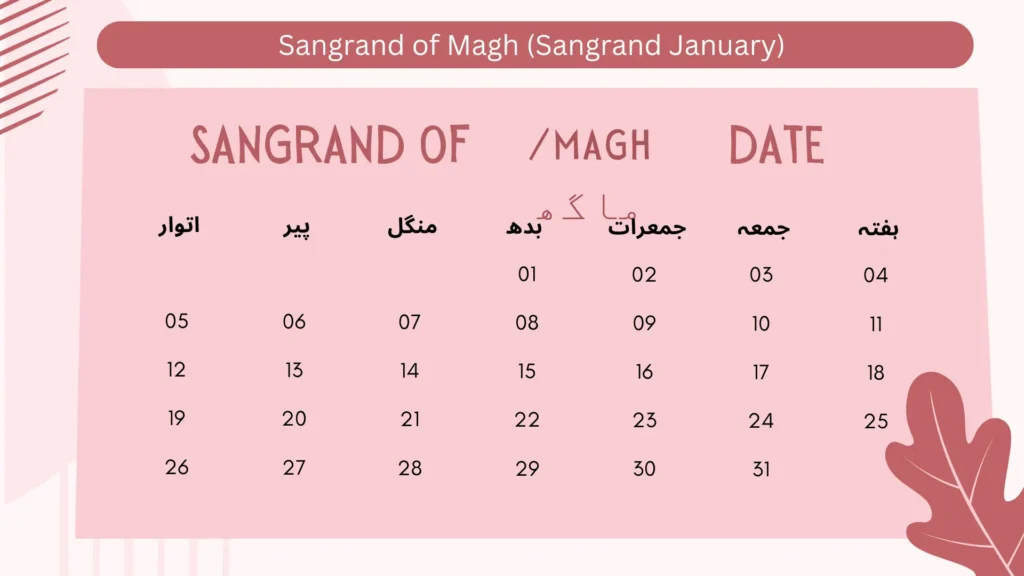Sangrand of Magh in January According to the Nanakshahi Samvat Calendar
The first day of the month of Magh or Maghi is known as the Sangrand of Magh or Maghi. On this day, Sikhs celebrate the changing of the month. January 13th is the 11th Sangrand of the year, as given to us by Saheb Siri Guru Nanak Dev Ji and Siri Guru Arjan Dev Ji in their Bani of Baramaha.
You can view the list of all Sangrand dates for each month in the current year. You can also see the English calendar dates for Sangrand in February, March, April, May, June, July, August, September, October, November, and December for the current year.

Celebration of the Chali Mukte During the Sangrand of Magh
Historical Background
During the Sangrand of Magh, we also celebrate the Chali Mukte, the 40 liberated ones. The Jatha, led by Bhai Maha Singh (ਭਾਈ ਮਹਾਂ ਸਿੰਘ – “Bhai Mahaan Singh”), consisted of those 40 Gursikh Singhs who came to Muktsar Sahib. They were from the area of Majha (ਮਾਝਾ – “Majha”), in the north of Punjab, which is now in present-day Pakistan.
The Battle of Muktsar
During the Battle of Muktsar, they had signed a Bedawa (ਬੇਦਾਵਾ – “Renunciation”) saying that they no longer considered Guru Gobind Singh Ji as their Guru. However, these 40 Gursikhs and the 41st Gursikh, Mai Bhago Ji (ਮਾਈ ਭਾਗੋ ਜੀ – “Mai Bhago Ji”), followed Guru Gobind Singh Ji to Muktsar Sahib. At Muktsar Sahib, the Mughal Empire forces were in pursuit of Guru Gobind Singh Ji.
The Sacrifice
At Khidrana (ਖਿਦਰਾਣਾ – “Khidrana”), now known as Muktsar, they fought a battle in the forest against the Mughal forces. Mai Bhago Ji was injured, but those 40 Gursikhs laid down their lives. Guru Gobind Singh Ji was watching over all of this. Guru Gobind Singh Ji came down, helped by Maha Singh. When he was blessing all these Gursikhs, he said, “Mera Dashan Hari, Mera Veeh Hazari, Mera Sawalakh Sikh,” blessing them for their futures and their afterlife.
The Request and Forgiveness
Guru Gobind Singh Ji asked Bhai Maha Singh to request anything. Bhai Maha Singh asked for the Bedawa to be torn so that those Sikhs would be forgiven and the Majha area would remain Sikhs of Guru Gobind Singh Ji. Guru Gobind Singh Ji tore the Bedawa, blessing the entire area along with those 40 Gursikhs and Mai Bhago Ji. So, on the day of Maghi, that is what we celebrate as Gursikhs.
Teachings of Guru Arjan Dev Ji During the Sangrand of Magh
Spiritual Cleansing During Sangrand of Magh
But what is the teaching that Guru Arjan Dev Ji gives us? “Magh Majan Sang Saduwa” (ਮਾਘ ਮਜਨ ਸੰਗ ਸਾਧੂਆਂ – “In the month of Magh, bathe with the saints”). In this month of Magh, we should cleanse ourselves in the company of the holy saints, those who have controlled their minds, or Man Nu Sadya Hoya (ਮਨ ਨੂੰ ਸੱਦਿਆ ਹੋਇਆ – “Controlled Mind”). Those who are victorious over their mind, so their mind is permanently fixed to the Charan (ਚਰਣ – “Feet”) of Akal Purakh Waheguru.
The Power of Seva and Sangat During the Sangrand of Magh
Physical Cleansing
“Magh Majan Sang Sadwa, Turi Kar Ishanan” (ਤੁਰੀਂ ਕਰ ਇਸਨਾਨ – “Bath with their dust”), and cleanse ourselves by bathing in their dust. If we take this literally, we can cleanse ourselves of the physical dust of the Sadh Sangat because when we go to the Gurdwara to do the Sangat of the holy, we get an opportunity to do their Seva (ਸੇਵਾ – “Service”). We can do Jodiyan Di Seva (ਜੁੱਤੀਆਂ ਦੀ ਸੇਵਾ – “Service of Shoes”) and clean their shoes, and that dust will come onto us, which will physically cleanse us.
Spiritual Cleansing
As Bhai Gurdas Ji describes, “Tappad Chardha Vishai Turi Naya” (ਤਪੜ ਚੜ੍ਹਦਾ ਵਿਸ਼ੇ ਤੁਰੀਂ ਨਾਇ – “Cleanse with dust”), we can cleanse ourselves with their dust when we are changing the Chadra (ਚਾਦਰਾ – “Sheet”) that the Sadh Sangat sits on. When we take the dust of the Chadra, that dust will fly and come onto us, and as it comes onto us, it will clean us.
“Saad Sangat Ki Turi Pari Ude Netri, Sab Dormat Maal Gavai” (ਸਾਧ ਸੰਗਤ ਕੀ ਤੁਰੀਂ ਪੜੀ ਉਦੈ ਨੇਤ੍ਰੀ, ਸਭ ਦੂਰਮਤ ਮਲ ਗਵੈ – “Dust in the eyes cleanses all”), Guru Granth Sahib Ji teaches us that the dust of the Sadh Sangat, when it comes off those Chadras and comes onto us, enters our eyes (Nethra – ਨੇਤ੍ਰ) and gives us the Purkash (ਪੁਰਕਾਸ਼ – “Light”) of Gyan (ਗਿਆਨ – “Knowledge”).
Embracing Positive Sangat During Sangrand of Magh
Avoiding Negative Influences
In the same way, we should be in this month, avoiding negative Sangat, Sangat that will take us away from our Guru, Sangat that will lead us down the wrong path, Sangat that will make us do harmful things that will poison our mind.
Seeking the Sangat of the Holy
We should find the Sangat of the holy, and when we see the Sangat of the sacred, as a bumblebee goes only to those flowers, we should extract all the honey from those flowers. When we do the Sangat of the holy, we extract Shabda Gun (ਸ਼ਬਦ ਗੁਣ “Divine qualities”) from them. We look at them, learn from them, take the teachings from them, and develop those teachings.
Achieving Spiritual Enlightenment
Not only are we physically being cleansed by taking their physical dust, but when we do the Sangat of these Sadhs spiritually, the teachings we gain from them, the knowledge, the Gyan we take from them, the Gun, the qualities, and characteristics we learn from them, are also cleansing us and giving us the Gyan Da Purkash (ਗਿਆਨ ਦਾ ਪੁਰਕਾਸ਼ “Light of Knowledge”). It’s the light of true knowledge being realized within us.
Conclusion
Guru Arjan Dev Ji’s Teachings
Sri Guru Arjan Dev Ji gives us that teaching this month of Magh. As we say, with love and Prem Nal (ਪ੍ਰੇਮ ਨਾਲ – “With Love”) Maghi, in this month of Magh, which is a winter month, the eleventh month of Sangrand, we are to do the Sangat of those Sadhs, those who have defeated their mind. We must cleanse ourselves by bathing in their dust, whether the literal dust by doing their Seva or the spiritual dust by cleansing ourselves, learning from them, taking the teachings of Gurusikhi, and implementing them into our lives.
A Prayer for Blessings
Let us hope and pray that Guru Sahib blesses us so we can take that dust in this month of Magh and cleanse ourselves, whether physically by doing their Seva or spiritually by learning from them.
